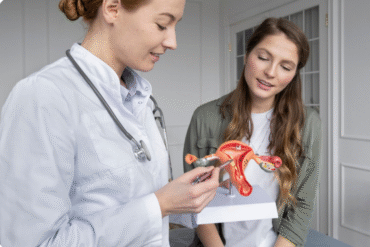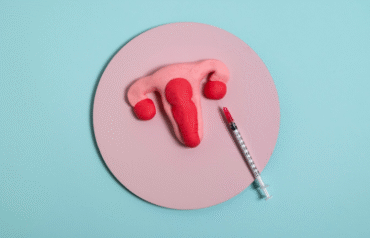The Latest Advances in Cervical Cancer Screening and Prevention
Hello! I’m Dr. Santoshi Nandigam, consultant gynecologist at The Birthwave Clinic, Chennai. In this comprehensive blog, we’ll explore what cervical cancer is, updates in screening, breakthroughs in prevention, and how we implement modern strategies at our clinic to protect women’s health.
1. Knowledge of Cervical Cancer
The cervix, the lower portion of the uterus that connects to the vagina, is where cervical cancer starts. Its main reason? a chronic infection with high-risk HPV types, particularly HPV 16 and 18, which cause more than 99% of cervical cancers.

Typical signs and symptoms:
Unusual vaginal bleeding (after menopause, during periods, or after sexual activity)
Unusual vaginal discharge that smells bad, is pink, or is watery
Chronic pain in the pelvis
Uncomfortable during sexual activity
Heavy or protracted menstrual flow
Since precancerous changes can frequently be found and treated before they progress, early detection through screening is the cornerstone of cervical cancer prevention.
2.The Importance of Cervical Cancer Prevention
About 660,000 new cases and 350,000 deaths from cervical cancer occurred in 2022, making it the fourth most common cancer in women worldwide. The majority of these deaths occurred in low- and middle-income nations with limited access to screening and vaccination.
The WHO has set goals to eradicate cervical cancer worldwide:
- By the age of 15, 90% of girls had received an HPV vaccination.
- By the ages of 35 and 45, 70% of women had undergone high-performance test screening.
- 90% of precancerous lesions receive the right care.
Reducing this burden requires preventative measures, such as HPV vaccination, thorough screening, and prompt treatment.
3.Developments in Screening for Cervical Cancer
Initial HPV Examination
The World Health Organization now advises HPV molecular testing as the main screening technique every five to ten years, beginning at age 30 in the majority of populations. Risk stratification by HPV type is now possible thanks to HPV mRNA tests and extended genotyping assays like BD Onclarity, which increase accuracy and cut down on needless follow-up.
In accordance with the American Cancer Society and ASCCP, the USPSTF encourages women aged 30 to 65 to have HPV tests performed by clinicians or by themselves every five years, and women aged 21 to 29 to have cytology-only screening every three years.
Dual-Stain Cytology (CINtec PLUS)
A significant advancement was the WHO’s approval of dual-stain cytology, which looks for p16 and Ki-67 biomarkers, as a method of triage for women with HPV. The ASCCP has incorporated it into its updated 2025 guidelines to identify women who are most at risk in order to reduce unnecessary colposcopies.
HPV Self-Sampling Examinations
According to recent research, self-collected HPV swabs are just as accurate as samples obtained from clinicians, and they also increase screening rates for women who are not being screened enough. This is being used by programs in Sweden, Australia, and now some areas of the United States to boost involvement.
Many users preferred an FDA-approved at-home uterine swab device, which resembles a tampon and has a 98% accuracy rate in first-attempt sample collection, over in-office exams.
New Tools for AI
In cytology classification, state-of-the-art AI systems such as Smart‑CCS (which employs large-scale pretraining and real-time adaptation) and transformer-based models (like EVA-02 fine-tuning) currently achieve AUCs of 0.95–0.97, indicating high accuracy in a variety of settings.
With telemedicine support, AI-assisted smartphone-based VIA screening is showing promise in low-resource areas, assisting nurses in conducting high-quality cytology camps.
4.HPV Vaccination: Key Developments in Prevention
With a 90% reduction in cervical precancer risk and more than ten years of long-term protection, the HPV vaccine has been revolutionary ([turn0search44]turn0search38). Based on studies demonstrating over 97% protection against HPV-16/18, WHO now recommends single-dose schedules for girls and young women aged 9–20, increasing access to vaccination globally .
Even though HPV vaccines like Gardasil and Cervavax are not yet included in India’s universal immunization schedule, efforts are being made to incorporate them into public health campaigns.
The American Cancer Society has called attention to lagging cervical cancer prevention in some populations because, despite advancements, many women are still not screened .
5.Treatment of Precancerous Lesions in Modern Times
In particular, women living with HIV or in settings with limited resources should prioritize screening, triage, and treatment, according to WHO’s updated guidelines.
These days, available treatments include:
- Either thermal ablation or cryotherapy
- Loop Electrosurgical Excision Procedure, or LEEP
- Cold knife conization is particularly useful when high-grade lesions are detected by dual-stain testing or extended genotyping.
The development of invasive cervical cancer is significantly slowed down by these early interventions.

6.Patient Journey at The Birthwave Clinic
Step 1: Risk Assessment Review medical and sexual history
Offer HPV testing and/or Pap smear-incorporating extended genotyping or dual-stain cytology as needed
Step 2: Examples of Choices
Clinician‐collected Pap/HPV
Self-sampling kits for women preferring home-based testing-especially helpful for those uncomfortable with pelvic exams
Step 3: Advanced Triage HPV-positive women may receive dual-stain cytology
Closer monitoring and shorter screening intervals are provided to high-risk individuals (such as women with HIV or those with a history of abnormal results).
Step 4: Therapy
Treatment with cryotherapy, LEEP, or other conservative excision methods is scheduled if precancerous changes are found.
Invasive disease is the reason for referrals to oncological services.
Step 5: Continued screening in accordance with WHO/ASCCP guidelines
HPV vaccination reinforcement if it hasn’t been given before
Step 6: Prevention Counseling Talk about HPV vaccination, which is best suited for people aged 9 to 45.
PAP follow-ups, smoking cessation, and safe sexual behavior as components of all-encompassing cervical cancer prevention
7.The Significance of These Innovations
More sensitivity and longer safe intervals are provided by HPV primary screening, which lowers frequency without compromising safety.
Dual-stain cytology maintains accuracy and safety while drastically lowering needless referrals.
Self-sampling improves uptake among past-due individuals and fills accessibility gaps.
Automated accuracy scalable to various clinical settings and LMIC environments is what AI-enhanced tools promise.
HPV vaccination in a single dose provides a highly effective and more accessible public health approach.
8.Reasons for Selecting The Birthwave Clinic to Prevent Cervical Cancer
We provide high-performance screening and triage tools while adhering to the most recent WHO and ASCCP guidelines.
In order to increase involvement and respect patient comfort, we use self-sampling kits.
HPV genotyping and sophisticated dual-stain cytology enable tailored follow-up.
Precancer treatment is available on-site or through referral channels.
Counseling for HPV vaccination as a component of prevention measures-even after adolescence
Holistic assistance that includes education, follow-up, and lifestyle
9.Suggestions for Takeout
- Depending on the health situation, begin screening at age 25–30 with HPV testing every 5–10 years or cytology every 3 years.
- Continue your regular cervical cancer screening even if you have received an HPV vaccination; screening is not completely replaced by the vaccine.
- Dual-stain cytology can direct selective colposcopy referrals for HPV-positive individuals and prevent overtreatment.
- If internal exams are an obstacle, use self-sampling HPV kits.
Talk about the HPV vaccine for women who qualify up until age 45; it’s crucial if it’s overlooked earlier.”
10.Conclusion :
Coordinated efforts in HPV vaccination, high-quality screening, and early treatment of precancerous lesions can prevent cervical cancer to a large extent. In order to provide Chennai women with top-notch preventive care, we at The Birthwave Clinic use the most recent developments, including dual-stain cytology, self-sampling, HPV primary screening, and AI-enabled technologies.
Preserving women’s futures requires protecting cervical health. Together, we can create a world where cervical cancer is almost completely eradicated.

